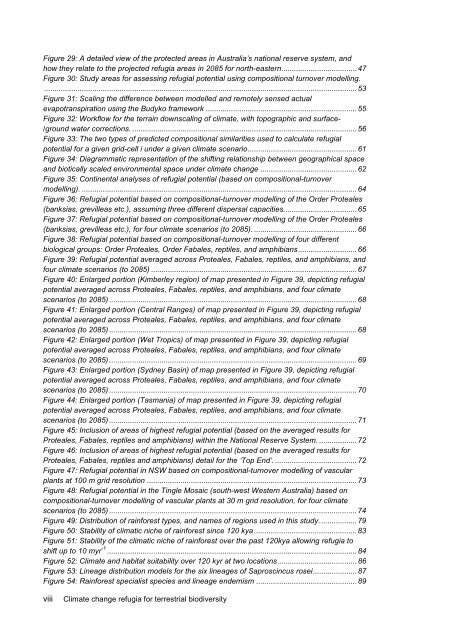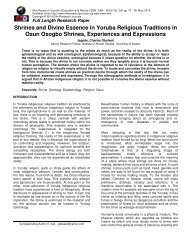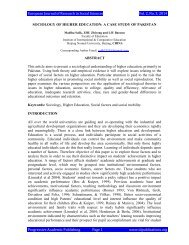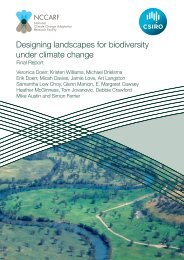Williams-Climate-change-refugia-for-terrestrial-biodiversity_0
Williams-Climate-change-refugia-for-terrestrial-biodiversity_0
Williams-Climate-change-refugia-for-terrestrial-biodiversity_0
Create successful ePaper yourself
Turn your PDF publications into a flip-book with our unique Google optimized e-Paper software.
Figure 29: A detailed view of the protected areas in Australia’s national reserve system, and<br />
how they relate to the projected <strong>refugia</strong> areas in 2085 <strong>for</strong> north-eastern .................................... 47<br />
Figure 30: Study areas <strong>for</strong> assessing <strong>refugia</strong>l potential using compositional turnover modelling.<br />
..................................................................................................................................................... 53<br />
Figure 31: Scaling the difference between modelled and remotely sensed actual<br />
evapotranspiration using the Budyko framework ........................................................................ 55<br />
Figure 32: Workflow <strong>for</strong> the terrain downscaling of climate, with topographic and surface-<br />
/ground water corrections. ........................................................................................................... 56<br />
Figure 33: The two types of predicted compositional similarities used to calculate <strong>refugia</strong>l<br />
potential <strong>for</strong> a given grid-cell i under a given climate scenario .................................................... 61<br />
Figure 34: Diagrammatic representation of the shifting relationship between geographical space<br />
and biotically scaled environmental space under climate <strong>change</strong> .............................................. 62<br />
Figure 35: Continental analyses of <strong>refugia</strong>l potential (based on compositional-turnover<br />
modelling). ................................................................................................................................... 64<br />
Figure 36: Refugial potential based on compositional-turnover modelling of the Order Proteales<br />
(banksias, grevilleas etc.), assuming three different dispersal capacities. .................................. 65<br />
Figure 37: Refugial potential based on compositional-turnover modelling of the Order Proteales<br />
(banksias, grevilleas etc.), <strong>for</strong> four climate scenarios (to 2085). ................................................. 66<br />
Figure 38: Refugial potential based on compositional-turnover modelling of four different<br />
biological groups: Order Proteales, Order Fabales, reptiles, and amphibians ............................ 66<br />
Figure 39: Refugial potential averaged across Proteales, Fabales, reptiles, and amphibians, and<br />
four climate scenarios (to 2085) .................................................................................................. 67<br />
Figure 40: Enlarged portion (Kimberley region) of map presented in Figure 39, depicting <strong>refugia</strong>l<br />
potential averaged across Proteales, Fabales, reptiles, and amphibians, and four climate<br />
scenarios (to 2085) ...................................................................................................................... 68<br />
Figure 41: Enlarged portion (Central Ranges) of map presented in Figure 39, depicting <strong>refugia</strong>l<br />
potential averaged across Proteales, Fabales, reptiles, and amphibians, and four climate<br />
scenarios (to 2085) ...................................................................................................................... 68<br />
Figure 42: Enlarged portion (Wet Tropics) of map presented in Figure 39, depicting <strong>refugia</strong>l<br />
potential averaged across Proteales, Fabales, reptiles, and amphibians, and four climate<br />
scenarios (to 2085) ...................................................................................................................... 69<br />
Figure 43: Enlarged portion (Sydney Basin) of map presented in Figure 39, depicting <strong>refugia</strong>l<br />
potential averaged across Proteales, Fabales, reptiles, and amphibians, and four climate<br />
scenarios (to 2085) ...................................................................................................................... 70<br />
Figure 44: Enlarged portion (Tasmania) of map presented in Figure 39, depicting <strong>refugia</strong>l<br />
potential averaged across Proteales, Fabales, reptiles, and amphibians, and four climate<br />
scenarios (to 2085) ...................................................................................................................... 71<br />
Figure 45: Inclusion of areas of highest <strong>refugia</strong>l potential (based on the averaged results <strong>for</strong><br />
Proteales, Fabales, reptiles and amphibians) within the National Reserve System. .................. 72<br />
Figure 46: Inclusion of areas of highest <strong>refugia</strong>l potential (based on the averaged results <strong>for</strong><br />
Proteales, Fabales, reptiles and amphibians) detail <strong>for</strong> the ‘Top End’. ....................................... 72<br />
Figure 47: Refugial potential in NSW based on compositional-turnover modelling of vascular<br />
plants at 100 m grid resolution .................................................................................................... 73<br />
Figure 48: Refugial potential in the Tingle Mosaic (south-west Western Australia) based on<br />
compositional-turnover modelling of vascular plants at 30 m grid resolution, <strong>for</strong> four climate<br />
scenarios (to 2085) ...................................................................................................................... 74<br />
Figure 49: Distribution of rain<strong>for</strong>est types, and names of regions used in this study. ................. 79<br />
Figure 50: Stability of climatic niche of rain<strong>for</strong>est since 120 kya ................................................. 83<br />
Figure 51: Stability of the climatic niche of rain<strong>for</strong>est over the past 120kya allowing <strong>refugia</strong> to<br />
shift up to 10 myr -1 ....................................................................................................................... 84<br />
Figure 52: <strong>Climate</strong> and habitat suitability over 120 kyr at two locations ...................................... 86<br />
Figure 53: Lineage distribution models <strong>for</strong> the six lineages of Saproscincus rosei ..................... 87<br />
Figure 54: Rain<strong>for</strong>est specialist species and lineage endemism ................................................ 89<br />
viii <strong>Climate</strong> <strong>change</strong> <strong>refugia</strong> <strong>for</strong> <strong>terrestrial</strong> <strong>biodiversity</strong>






